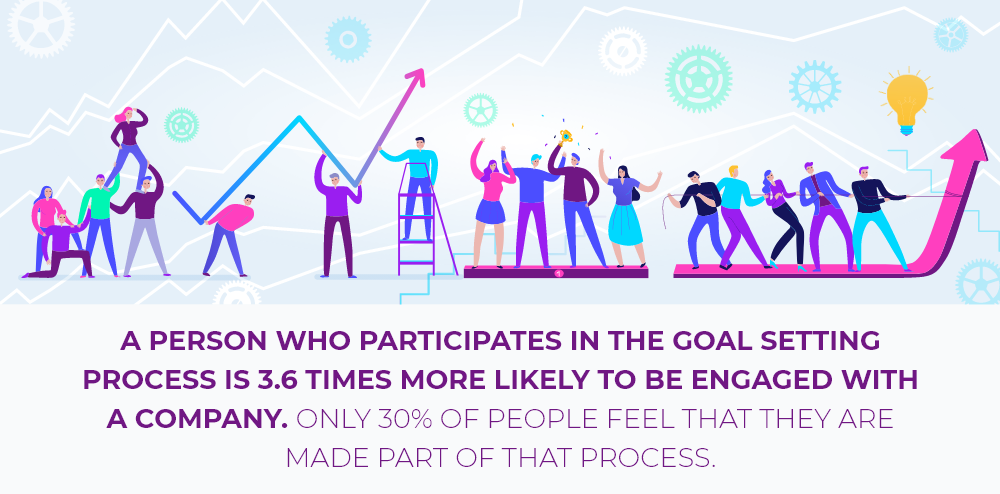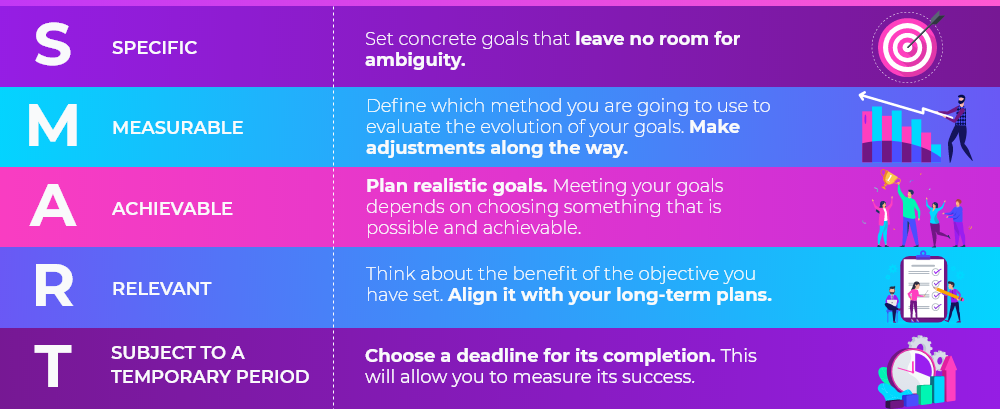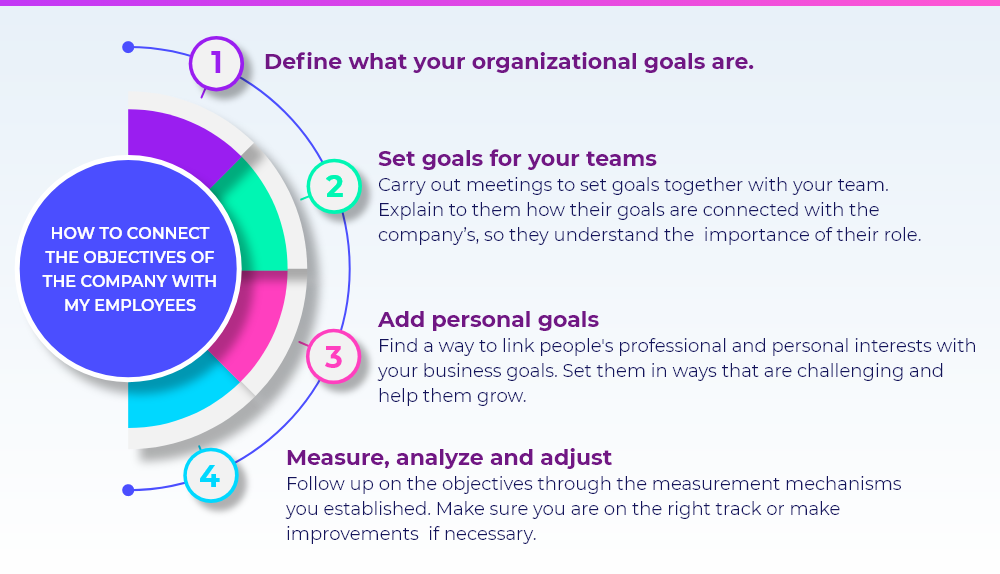OKRs and SMART Goals: The Definitive Guide
Written by Florencia Paez
What do Google, Twitter and Linkedin have in common? The three organizations have found a fair way to merge achievable – and measurable – goals, with a strategy on how they plan to get the results they seek. Part of their secret is that they have been implementing working approaches such as SMART Goals and OKRs (Key Objectives and Results) for a long time.
But you don’t have to be an industry titan to achieve such a magical combination. In this article, we tell you all about these two goal-setting tools, and how they can help your company. As a plus, if you read to the end we’ll walk you through their implementation thanks to our Definitive Guide to SMART Goals and OKRs.
The year we left behind proved to be a challenge for companies when it came to setting goals since they had to change course abruptly more than once during the past 12 months. Thus, while they had to turn their backs to some of their goals, others had to be postponed, and many more became outdated. All this, added to the sudden adaptation to hybrid work models and the difficulties to carry out effective communication within companies, led work teams to face uncertainty and misunderstandings about the organization’s priorities.
When employees experience uncertainty and lack of clarity, their level of commitment towards their daily tasks and the organization in general, falls off. This represents a great risk for any leader since people with little commitment tend to become less responsible with their work, show lack of interest in their professional development, and don’t feel driven to continue learning. All of these factors are expected to lead to a drastic decline in productivity.
I bet there’s no leader who has not wondered, at some point, if it is possible to increase the commitment between his teams and at the same time achieve his business objectives. The answer is yes, but the first step they must take is to effectively involve employees with the results of the organization. A person who actively participates in the goal setting process is 3.6 times more likely to be engaged with your company. However, only 30% of people feel that they are made part of that process.

So, how can leaders make their people take part in the process of planning feasible, trackable, and measurable goals? We’ll present two tools, the OKRs and the SMART Methodology – your best allies to boost your team’s growth.
What are SMART goals?
SMART Goals definition goes like this: It’s an acronym that represents the words Specific, Measurable, Achievable, Relevant and subject to a Time limit. In each letter of its name, it contains an element that works alongside the other to define a deeply thought, concrete and measurable objective. This type of approach allows you to set goals using a very specific criterion that helps you achieve it within a certain period of time.
Have you ever set a goal that you couldn’t reach because it was too unspecific or too ambitious? The planning, specificity and measurement capacity of SMART goals will help you make all your objectives realistic and achievable because its approach seeks to do away with generality. In turn, that makes it much easier for you to keep updated with its evolution and identify when you should make modifications.

– Objective: Improve my command of the English language
– Specific: I would like to conduct a meeting entirely in English at the end of this year. To improve my conversation skills, I need to take a language course and dedicate an hour of practice every week.
– Measurable: By the end of this year, I will be able to conduct a meeting entirely in English, chatting with participants and answering any questions that come up.
– Achievable: In today’s global context, working on my language skills is key both for my professional development and to connect more efficiently with the different offices of my company. Dedicating one hour per week to an English class is a feasible commitment within my work schedule.
– Relevant: The company I work for has five offices in two continents, and the language used to communicate is English. This goal will help my teams understand what I need from them and deepen our peer relationships.
– Timeframe: Eight months from now, I will have completed the advanced English module and will lead a team meeting in English.
What are OKRs?
OKRs, or Key Objectives and Results, are a collaborative tool that allows setting individual, team, or organizational objectives. The objectives focus on a qualitative description of what we seek to achieve, while the Key Results are the quantitative component that helps us measure the progress and fulfillment of the goals proposed.
The Goals represent the results we aim for and, therefore, must be concrete, important, inspirational, and concrete-action oriented. The Key Results, on the other hand, allow us to effectively monitor how well we’re doing with everything we set out to do. Therefore, goals must be realistic, capable of being measured and verified, and have definable time periods. All this helps to evaluate and rate our level of success and the points improve at the end of the established term.

– Objective: Improve the satisfaction of our clients.
– KR1: Carry out and analyze 40 satisfaction surveys during Q1.
– KR2: Carry out two training sessions for teams that work with clients in Q1.
– KR3: Increase our NPS from 6 to 7.
– KR4: Keep 90% of our clients in Q1.
Oh! So, which one should I choose now?
Although OKRs and SMART Goals may be quite similar at first glance, they differ in the way they state the objectives. For example, SMART goals use a metric to be measured, while OKRs usually include a large number of variables that allow the understanding of their progress and results. OKRs tend to be a bit more “flexible” when it comes to measuring themselves, since it is said that achieving 70% of the goals proposed is enough to consider the process a success. Instead, SMART goals generally require 100% of goal achievement.
This does not mean that one is better than the other – its implementation depends on the results we want and the context in which we want them to happen. The main purpose we should seek with these types of tools is to focus on what is important to our company, and make employees be part of each common goal.
Through clear OKRs and SMART Goals, people stay more focused, as we’re giving them clear information and guidance on what priorities should be set. At the same time, this increases the empowerment and engagement employees feel towards their tasks, because the combination of personal and organizational objectives makes individuals witness how their daily activities impact on the results of the company.

In order to help you make this process simple, there are currently digital performance management platforms, such as StarMeUp, which allow you to set organizational, team, or individual objectives by combining them with approaches such as Smart Objectives. This solution gives you the possibility to access information on your employees’ feedback and performance evaluations so that you can detect areas for improvement and link your organizational priorities with people’s professional growth. In addition, aligning what the company seeks with what employees want for their professional development provides clarity and helps prevent burnout, frustration, job stress, and even staff turnover.
Our Definitive Guide to Creating SMART Goals and OKRs
Time to plan your goals
You must have noticed that, to enhance your employees’ commitment towards their tasks and make your company progress, it is necessary to intertwine personal, professional, and team goals with organizational ones so that everyone feels involved and responsible for the destiny of the company. Consequently, your people will see how important their work is, and they’ll feel more valued and connected with their daily tasks.
Approaches such as OKRs and Smart Goals are two tools that help companies propose concrete, trackable and achievable goals. In the case of Smart Goals, they can be integrated with a performance management platform like StarMeUp, which allows you and your teams to keep track of the progress of those objectives and make adjustments over time. This is the perfect recipe to ensure the constant growth of your employees and your company.